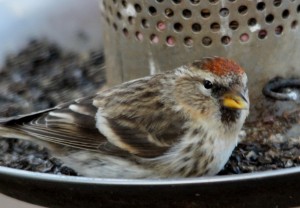 There is a rapid turnover of birds in the garden coming to feeders at the moment. Although some bird will stay and breed in the garden or nearby, many will leave for other areas. In the case of the chaffinch things get a little more complicated. Some of the birds that have frequented our garden all winter have come from Scandinavia and will now move back there to breed. Siskins have been one of the dominant birds in gardens this winter with many readers getting in touch with me expressing their pleasure at just how common they have been. Some will possibly breed in the garden, I had a pair that built their nest in a small conifer in the garden a few years ago. However, most of the siskins will move out once the warmer weather comes. They will breed in the large areas of conifer woodland and there the female will build the small neat cup shaped nest from conifer twigs, grass, heather, moss and spiders’ webs. Whilst the female builds the nest and incubates the eggs, the male joins them after hatching and will share in feeding the young even when they first leave the nest. Many people will see them when they come back to the feeders in gardens. Bird feeders must be like picnic tables to them with a constant source of food always there.
There is a rapid turnover of birds in the garden coming to feeders at the moment. Although some bird will stay and breed in the garden or nearby, many will leave for other areas. In the case of the chaffinch things get a little more complicated. Some of the birds that have frequented our garden all winter have come from Scandinavia and will now move back there to breed. Siskins have been one of the dominant birds in gardens this winter with many readers getting in touch with me expressing their pleasure at just how common they have been. Some will possibly breed in the garden, I had a pair that built their nest in a small conifer in the garden a few years ago. However, most of the siskins will move out once the warmer weather comes. They will breed in the large areas of conifer woodland and there the female will build the small neat cup shaped nest from conifer twigs, grass, heather, moss and spiders’ webs. Whilst the female builds the nest and incubates the eggs, the male joins them after hatching and will share in feeding the young even when they first leave the nest. Many people will see them when they come back to the feeders in gardens. Bird feeders must be like picnic tables to them with a constant source of food always there.
There is a mystery here that was mentioned in this column over a year ago and it does not seem to have been resolved. In the “wild” in the Highlands siskins will often mix with lesser redpolls and down south in England both species come freely to feeders in gardens. Records from the south indicate that last winter in particular the number of lesser redpolls rose to almost the same as the siskins. Yet in the Highlands the records of lesser redpolls at bird feeders in garden are still few and far between. For example in my garden this last winter we have only had two records, one well before Christmas for a couple of hours and then another in the last week or so. The last one was, judging by the lack of pink feathers on the breast, was a female and by the general plumage likely to be a young bird hatched last year. Just occasionally it comes into feed and always on the nyger feeder with siskins and this is where I took the photograph. The bird is in the spillage tray under the main part of the feeder and, by co-incidence, it is there as I write these notes. The photograph was taken through the glass window with a telephoto lens, a Sigma 150 to 500 mm. The small and neat black bib under the beak and the reddish cap are diagnostic features. Interestingly the red cap varies in colour and can be an attractive gold colour although is unusual.
The other attractive bird in the garden this winter and again commented on by readers has been the large numbers of bramblings. These are about the same size as the chaffinch but much more colourful, especially the male birds. Whilst a very small number of bramblings may stay to breed in the Highlands, often only one or two pairs, but in the winter it is a different matter. The winter numbers are variable from year to year. In poor years there may be only around 1,000 birds whilst in a bumper year this can rise to a staggering 100,000 birds and all from north west Europe. So if like me there are still a few bramblings in your garden they will soon leave for Scandinavia,
